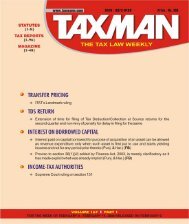news round up - Taxmann
news round up - Taxmann
news round up - Taxmann
- TAGS
- news
- round
- taxmann
- taxmann.com
You also want an ePaper? Increase the reach of your titles
YUMPU automatically turns print PDFs into web optimized ePapers that Google loves.
2010] ANALYSIS ON PROSPECTS OF IMPLEMENTATION OF GST IN INDIA 129<br />
AN ANALYSIS ON PROSPECTS OF IMPLEMENTATION OF<br />
GOODS AND SERVICES TAX IN INDIA<br />
VIVEK KOHLI, ASHWANI SHARMA & SUDEEP VIJAYAN*<br />
The proposed introduction of Goods and Services Tax in India is<br />
an attempt by the Government of India to rationalize the current<br />
indirect tax regime and to bring a more transparent and<br />
efficient tax system. This article provides a selective analysis on a few<br />
broad areas of the proposed GST model, in order to encourage a<br />
widespread public debate to bring into light more issues and<br />
concerns prior to finalization of the Goods and Service Tax regime for<br />
India. The author opines that the introduction of the GST regime<br />
would definitely go a long way in improving and rationalizing the quality<br />
of the indirect tax regime as it incorporates all the desirable features<br />
of an efficient tax system.<br />
Introduction<br />
1. The proposed introduction of goods and services tax in India is an<br />
attempt by the Government of India with an objective to rationalize the<br />
current indirect tax regime in India, to bring about a more transparent and<br />
efficient tax regime in place. At present any assessee, in order to pursue its<br />
business activity, is required to pass through various levels of taxation,<br />
namely, at the National level, State level and in certain cases even at the<br />
sub-State level. The tax liability at all of the above stages is influenced by<br />
various factors, namely - multiple tax rates, cascading nature of taxes, tax<br />
administration complexities (separate authorities for most of the taxes),<br />
high compliance costs, cross-adjustment of tax credit (only allowed<br />
among certain taxes), adjustment/refund of tax, etc. Therefore, in order<br />
to ensure uniformity and boost efficiency, and rightfully to make India a<br />
competitive trading destination among the committee of nations, the<br />
Government of India has initiated its transition towards the Goods and<br />
Service Tax (GST) regime. The indirect taxation system in India has<br />
evolved over the years and has been witness to a series of structural as well<br />
as systemic changes within it - the more significant among all of them<br />
being the value-added taxation or the VAT regime. The implementation of<br />
VAT regime benefited the Government of India as well as the trade/<br />
industry in a large way by bringing in a more visible tax structure which<br />
enhanced compliance through a degree of self-assessment, ultimately<br />
leading to reduction in pilferage of taxes. The VAT regime, though<br />
substantial in nature still suffered from various anomalies in the nature of<br />
multiple taxation, adverse cascading effect of taxes, etc., which have,<br />
*The authors are Senior Partner, Managing Associate, Associate, respectively at ZEUS<br />
Law Associates, New Delhi.<br />
GOODS & SERVICES TAX CASES ❑ JANUARY 20 - FEBRUARY 4, 2010 ◆ 39











![“FORM NO. 3CEB [See rule 10E] Report from an ... - Taxmann](https://img.yumpu.com/45480232/1/190x245/form-no-3ceb-see-rule-10e-report-from-an-taxmann.jpg?quality=85)





